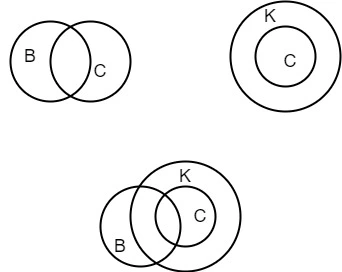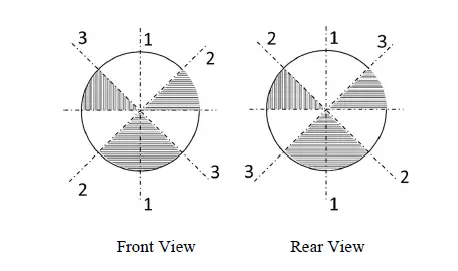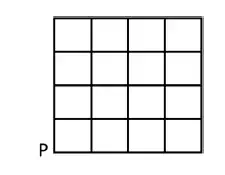Questions 1 to 10 Solutions
Q.1 – Q.5 Carry ONE mark each.
Q.1 As you grow older, an injury to your ____ may take longer to ___-.
(A) heel / heal
(B) heal / heel
(C) heal / heal
(D) heel / heal
Ans. D) heel / heal
Solution: It is an example of homophones so option (d) will be suitable in the given problem.
Q.2 In a 500 m race, P and Q have speeds in the ratio of 3 ∶ 4. Q starts the race when P has already covered 140 m. What is the distance between P and Q (in m) when P wins the race?
(A) 20
(B) 40
(C) 60
(D) 140
Ans. (A) 20
Solution:- Let us consider x as proportionality constant ,
So, P=3x and Q=4x
Therefore, According to the given condition, P has covered 140 m so, P= 500-140 = 360
P=360
3x= 360
x=120 m
Q=4x= 4 x 120 = 480 m
So , P reaches 500 meters and Q reaches only upto 480 m .
The distance between P and Q is 500-480 = 20 m
Therefore, option (a) is correct.
Q.3 Three bells P, Q, and R are rung periodically in a school. P is rung every 20 minutes; Q is rung every 30 minutes and R is rung every 50 minutes. If all the three bells are rung at 12:00 PM, when will the three bells ring together again the next time?
(A) 5:00 PM
(B) 5:30 PM
(C) 6:00 PM
(D) 6:30 PM
Ans. (A) 5:00 PM
Solution: The given three bells are P,Q,R
P= 20 minutes
Q= 30 minutes
R= 50 minutes
Taking LCM of 20,30,50
So LCM= 300 minutes = 5 hours
12.00 PM + 5 hours = 5 P.M.
So taking 5 hours from afternoon 12 we get time as 12.00 PM to 5.00 Pm
Therefore it will be 5 P.M
Q.4 Given below are two statements and four conclusions drawn based on the statements.
Statement 1: Some bottles are cups.
Statement 2: All cups are knives.
Conclusion I: Some bottles are knives.
Conclusion II: Some knives are cups.
Conclusion III: All cups are bottles.
Conclusion IV: All knives are cups.
Which one of the following options can be logically inferred?
(A) Only conclusion I and conclusion II are correct
(B) Only conclusion II and conclusion III are correct
(C) Only conclusion II and conclusion IV are correct
(D) Only conclusion III and conclusion IV are correct
Ans. (A) Only conclusion I and conclusion II are correct
Solution: We can solve this by using Venn diagram
So the following venn diagram can be drawn from the above statements

So, option (a) is the correct answer.
Q.5 The figure below shows the front and rear view of a disc, which is shaded with identical patterns. The disc is flipped once with respect to any one of the fixed
axes 1-1, 2-2 or 3-3 chosen uniformly at random. What is the probability that the disc DOES NOT retain the same front and rear views after the flipping operation?

(A) 0
(B) 1/3
(C) 2/3
(D) 1
Ans.(C) 2/3
Ans. Given that there are 3 disc . So let us consider n= Total = 3
m= favourable = disc does not retain same front and rear view after flipping = 2
So the probability that disc does not retain the same front views after flipping operation is
Probability =m/n = 2/3
Q. 6 – Q. 10 Carry TWO marks each.
Q.6 Altruism is the human concern for the wellbeing of others. Altruism has been shown to be motivated more by social bonding, familiarity and identification of
belongingness to a group. The notion that altruism may be attributed to empathy or guilt has now been rejected. Which one of the following is the CORRECT logical inference based on the information in the above passage?
(A) Humans engage in altruism due to guilt but not empathy
(B) Humans engage in altruism due to empathy but not guilt
(C) Humans engage in altruism due to group identification but not empathy
(D) Humans engage in altruism due to empathy but not familiarity
Ans. (C) Humans engage in altruism due to group identification but not empathy
Q.7 There are two identical dice with a single letter on each of the faces. The following six letters: Q, R, S, T, U, and V, one on each of the faces. Any of the
six outcomes are equally likely. The two dice are thrown once independently at random. What is the probability that the outcomes on the dice were composed only of any combination of the following possible outcomes: Q, U and V?
(A) 1/4
(B) 3/4
(C) 1/6
(D) 5/36
Ans. (A) 1/4
Solution :- There are two dice meas each dice has 6 letters so
The probability that the outcomes on the dice is combination of Q,U and V is
P(E) = \frac{Favourable}{Total} = \frac{3}{6}\times \frac{3}{6}
P(E) = \frac{1}{4}
Q.8 The price of an item is 10% cheaper in an online store S compared to the price at another online store M. Store S charges ₹ 150 for delivery. There are no
delivery charges for orders from the store M. A person bought the item from the store S and saved ₹ 100. What is the price of the item at the online store S (in ₹) if there are no other charges than what is described above?
(A) 2500
(B) 2250
(C) 1750
(D) 1500
Ans.(B) 2250
Solution:- According to the given information there are two online stores S and M,
Assume Cap price on store M is x
Price on S = (x-0.1 x) = 0.9 x
So Delivery charges on S = Rs. 100 (Given)
x-(0.9x + 150) = 100
0.1x-150 = 100
x= 2500
Therefore price on store S = 0.9 x = 0.9 x 2500 = 2250
Q.9 The letters P, Q, R, S, T and U are to be placed one per vertex on a regular convex hexagon, but not necessarily in the same order. Consider the following statements:
The line segment joining R and S is longer than the line segment joining P and Q.
The line segment joining R and S is perpendicular to the line segment joining P and Q.
The line segment joining R and U is parallel to the line segment joining T and Q.
Based on the above statements, which one of the following options is CORRECT?
(A) The line segment joining R and T is parallel to the line segment joining Q and S
(B) The line segment joining T and Q is parallel to the line joining P and U
(C) The line segment joining R and P is perpendicular to the line segment joining U and Q
(D) The line segment joining Q and S is perpendicular to the line segment joining R and P
Ans. (A) The line segment joining R and T is parallel to the line segment joining Q and S
Q.10 An ant is at the bottom-left corner of a grid (point P) as shown above. It aims to move to the top-right corner of the grid. The ant moves only along the lines
marked in the grid such that the current distance to the top-right corner strictly decreases. Which one of the following is a part of a possible trajectory of the ant during the movement?

| (A) |  |
| (B) |  |
| (C) |  |
| (D) |  |
Ans. (C)
